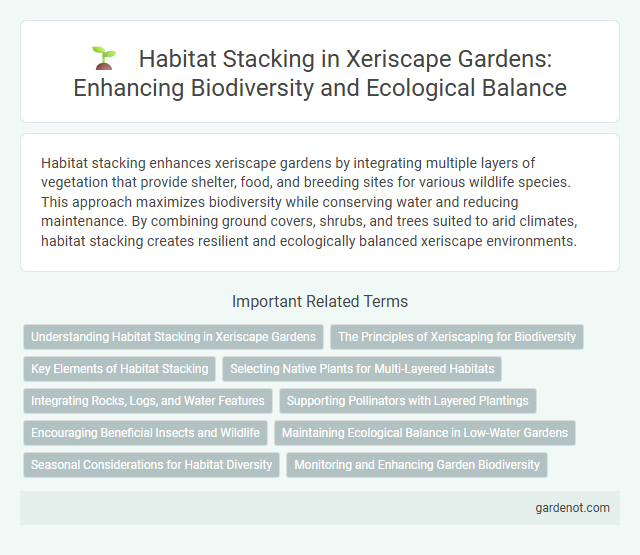Habitat stacking enhances xeriscape gardens by integrating multiple layers of vegetation that provide shelter, food, and breeding sites for various wildlife species. This approach maximizes biodiversity while conserving water and reducing maintenance. By combining ground covers, shrubs, and trees suited to arid climates, habitat stacking creates resilient and ecologically balanced xeriscape environments.
Understanding Habitat Stacking in Xeriscape Gardens
Habitat stacking in xeriscape gardens involves layering diverse plant species and microhabitats to attract and support a wider range of native wildlife, enhancing ecosystem resilience. By integrating ground covers, shrubs, and canopy layers within drought-tolerant landscapes, xeriscaping maximizes limited water resources while promoting biodiversity. This technique encourages beneficial insects, birds, and pollinators, creating a self-sustaining habitat that thrives in arid climates.
The Principles of Xeriscaping for Biodiversity
Habitat stacking in xeriscaping integrates vertical layers of native plants to maximize biodiversity, enhancing microhabitats for birds, insects, and small mammals. Strategic selection of drought-tolerant species with varying root depths optimizes water usage and supports diverse ecosystems within arid landscapes. Implementing xeriscaping principles like soil improvement and mulching promotes resilience while fostering a balanced habitat that sustains native wildlife populations.
Key Elements of Habitat Stacking
Habitat stacking enhances xeriscape gardens by incorporating multiple layers such as ground covers, shrubs, and trees to maximize biodiversity and resource efficiency. Key elements include selecting native drought-tolerant plants, providing diverse structural habitats for wildlife, and optimizing soil moisture retention through mulching and organic amendments. Integrating vertical and horizontal plant diversity reduces water usage while supporting pollinators and beneficial insects in arid landscapes.
Selecting Native Plants for Multi-Layered Habitats
Selecting native plants for habitat stacking in xeriscape gardens enhances biodiversity by creating multi-layered habitats that support diverse wildlife species. Incorporating ground covers, shrubs, and canopy layers of drought-tolerant native plants optimizes water use efficiency and provides shelter, food, and breeding sites for pollinators, birds, and beneficial insects. Native species such as California sagebrush, yarrow, and manzanita thrive in xeric conditions while promoting ecological resilience and soil health.
Integrating Rocks, Logs, and Water Features
Habitat stacking in xeriscape design enhances biodiversity by integrating rocks, logs, and water features to create diverse microhabitats that support various wildlife species. Rocks provide shelter for reptiles and insects, while logs offer nesting sites and feeding grounds for birds and small mammals. Incorporating water features such as rain gardens or small ponds supports amphibians and pollinators, boosting the ecological value of low-water landscapes.
Supporting Pollinators with Layered Plantings
Habitat stacking enhances xeriscape designs by integrating layered plantings that provide diverse resources for pollinators throughout the growing season. Deep-rooted native shrubs, mid-height flowering perennials, and ground-cover plants create varied microhabitats supporting bees, butterflies, and hummingbirds. This stratified approach maximizes nectar availability, shelter, and nesting sites, promoting pollinator health and biodiversity in water-wise landscapes.
Encouraging Beneficial Insects and Wildlife
Habitat stacking in xeriscape gardens promotes biodiversity by providing multiple layers of vegetation that attract beneficial insects like pollinators and predatory species. Incorporating native plants such as milkweed, lavender, and sage creates a thriving environment for butterflies, bees, and ladybugs, which naturally control pests and enhance pollination. This approach supports wildlife habitats while optimizing water conservation, making xeriscaping both eco-friendly and sustainable.
Maintaining Ecological Balance in Low-Water Gardens
Habitat stacking in xeriscape gardens enhances ecological balance by integrating diverse plant species with varying water needs, creating microhabitats that support native wildlife and beneficial insects. This layered planting approach reduces water consumption while promoting soil health and natural pest control. Effective habitat stacking fosters a resilient ecosystem that thrives in arid conditions, ensuring sustained biodiversity and resource efficiency.
Seasonal Considerations for Habitat Diversity
Habitat stacking in xeriscaping enhances biodiversity by incorporating plant and structural elements that provide resources across multiple seasons. Selecting native drought-tolerant species with staggered bloom and seed production timings ensures continuous shelter and food supply for pollinators, birds, and beneficial insects year-round. Seasonal variation in microhabitats supports diverse life cycles, promoting ecosystem resilience and overall habitat health in water-efficient landscapes.
Monitoring and Enhancing Garden Biodiversity
Habitat stacking in xeriscape gardens involves layering multiple plant species and structures to maximize ecological niches and support diverse wildlife populations. Regular monitoring using biodiversity indices helps assess the presence of pollinators, beneficial insects, and soil microbes, guiding targeted enhancements such as introducing native plants or installing water-efficient features. These practices improve garden resilience and contribute to local ecosystem health by fostering a self-sustaining, vibrant habitat.
Habitat stacking Infographic

 gardenot.com
gardenot.com